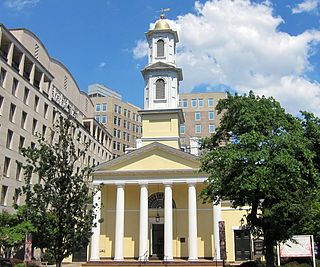
The religious affiliations of presidents of the United States can affect their electability, shape their stances on policy matters and their visions of society and also how they want to lead it. Speculation of Thomas Jefferson, Abraham Lincoln, William Howard Taft, and Donald Trump being atheists was reported during election campaigns, while others, such as Jimmy Carter, used faith as a defining aspect of their campaigns and tenure to hold the office.
Religious conversion is the adoption of a set of beliefs identified with one particular religious denomination to the exclusion of others. Thus "religious conversion" would describe the abandoning of adherence to one denomination and affiliating with another. This might be from one to another denomination within the same religion, for example, from Protestant Christianity to Roman Catholicism or from Sunnī Islam to Shīʿa Islam. In some cases, religious conversion "marks a transformation of religious identity and is symbolized by special rituals".
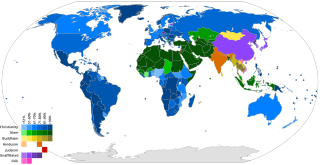
A religious denomination is a subgroup within a religion that operates under a common name and tradition among other activities. The term refers to the various Christian denominations. It is also used to describe the five major branches of Judaism. Within Islam, it can refer to the branches or sects, as well as their various subdivisions such as sub-sects, schools of jurisprudence, schools of theology and religious movements.
The world's principal religions and spiritual traditions may be classified into a small number of major groups, though this is not a uniform practice. This theory began in the 18th century with the goal of recognizing the relative levels of civility in different societies, but this practice has since fallen into disrepute in many contemporary cultures.

James Legge was a Scottish linguist, missionary, sinologist, and translator who was best known as an early translator of Classical Chinese texts into English. Legge served as a representative of the London Missionary Society in Malacca and Hong Kong (1840–1873) and was the first Professor of Chinese at Oxford University (1876–1897). In association with Max Müller he prepared the monumental Sacred Books of the East series, published in 50 volumes between 1879 and 1891.

The Schaff–Herzog Encyclopedia of Religious Knowledge is a religious encyclopedia. It is based on an earlier German encyclopedia, the Realencyklopädie für protestantische Theologie und Kirche. Like the Realencyklopädie, it focuses on Christianity from a primarily Protestant point of view. The final edition, titled The New Schaff–Herzog Encyclopedia of Religious Knowledge, was published 1908–14 in 13 volumes, based on the third edition of the Realencyklopädie (1896–1909).

Hannah Adams was an American author of books on comparative religion and early United States history. She was born in Medfield, Massachusetts and died in Brookline. Adams was the first woman in the U.S. who worked professionally as a writer.
Antitactæ, or antitactici, in antiquity, were a Gnostic sect who believed that God was good and just, but that one of his creatures had created evil, and had engaged humans to follow it, in order to set us in opposition to God. They believed that it was the duty of humanity to oppose this author of evil, in order to avenge God of his enemy. Their name is from the ancient Greek for "I oppose; I am contrary".
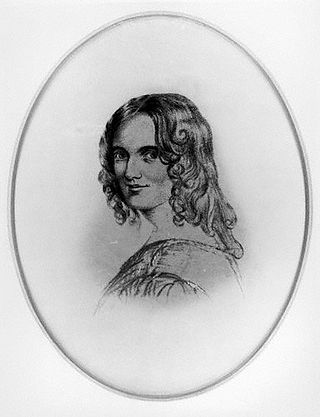
Sarah Fuller Flower Adams was an English poet and hymnwriter. A selection of hymns she wrote, published by William Johnson Fox, included her best-known one, "Nearer, My God, to Thee", reportedly played by the band as the RMS Titanic sank in 1912.
In the Latter Day Saint movement, the great and abominable church is a church described in the Book of Mormon and other revelations by Joseph Smith. The great and abominable church is identified as being synonymous with the Whore of Babylon described in chapter 17 of the Book of Revelation. Although many Latter Day Saints have associated the great and abominable church with the Catholic Church, official publications of the Church of Jesus Christ of Latter-day Saints have discouraged this interpretation.

Various sociological classifications of religious movements have been proposed by scholars. In the sociology of religion, the most widely used classification is the church-sect typology. The typology is differently construed by different sociologists, and various distinctive features have been proposed to characterise churches and sects. On most accounts, the following features are deemed relevant:
Charles Buck (1771–1815) was an English Independent minister and theological writer, known for his Theological Dictionary.
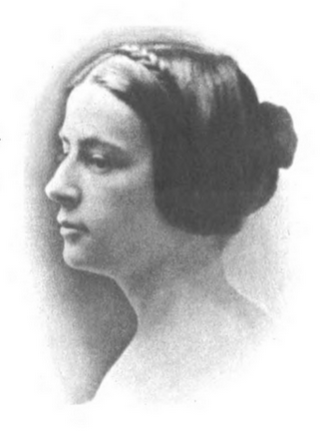
Martha Perry Lowe was an American writer of poetry and prose, as well as a social activist and organizer. She supported women's rights, temperance, education, and Unitarian organizations. Born in New Hampshire in 1829, her parents were General Justus Perry and Hannah Wood. She was a descendant of William Wood, the supposed author of New England's Prospects, who left England and settled in Concord in 1638. At the age of 15, Lowe was sent to Sedgwick's School for Young Ladies. After her graduation, she spent a winter in the West Indies, and the following year was passed in Madrid with her brother, who was a member of the Spanish legation. In 1857, she married the Rev. Charles Lowe who died in 1874, and at the time of his death was a member of the Somerville school committee. In 1871, when the family went to Europe, Lowe corresponded regularly for the Liberal Christian. In Somerville, she was connected with the Unitarian Review. She was the author of several books of prose and poetry; the most noted ones include The Olive and the Pine, Love in Spain, and a Memoir of Charles Lowe. She was interested in many public and private philanthropies, but her chief interests were in the public schools. She was among the first to advocate the teaching of cooking and sewing, and at her suggestion a sum of money was raised for that purpose. She was one of the founders of the Educational Union in Somerville, one of whose duties was a regular visitation of the schools by its members. She was a member of the Society of American Authors of New York, the Authors' Club of Boston, the Woman's Education Association, and the Unitarian Church Temperance Society, as well as an honorary member of the Castilian Club, of the Heptorean Club, of the Teachers' Annuity Guild, honorary president of the Woman Suffrage League, a director of the Massachusetts Suffrage Association, president of the Woman's Alliance of the First Unitarian Church, and a member of the Cambridge Branch of the Indian Association. She died in Massachusetts in 1902.
Mary Hall Adams was a 19th-century American book editor and letter writer. Her writing include: Sabbath School annual for 1846-, Never give up, or, How children may be happy, and The Rainbow and Other Stories: A Juvenile Gift. Adams died in 1860.
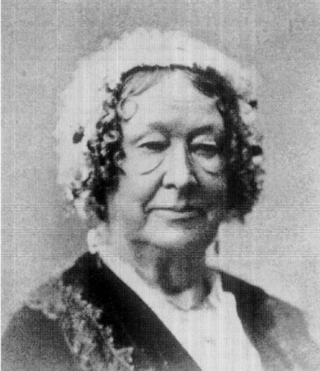
Eunice Hale Cobb was an American writer, public speaker, and activist. She was born in Kennebunk, Maine, in 1803 and she married Rev. Sylvanus Cobb in Hallowell, Maine, in 1822. She was a devoted and efficient assistant to his religious work as a Universalist preacher. Her eldest son, Sylvanus, Jr., derived much of his noted faculty for story-telling from her practice of telling him stories – often continued from evening to evening, as he sat at her feet when a child. She wrote hymns, and occasional poems, and obituary lines. Her faith in God was expressed in all her poetry. As a public speaker, she was very persuasive and convincing. She was the first female president of the Ladies Physiological Institute, of Boston, and served it in that capacity for some 15 years. She died in 1880.

A Summary History of New-England is an 18th-century history book regarding New England by the American author, Hannah Adams. It was first published in Dedham, Massachusetts in 1799, by Herman Mann and James H. Adams, and followed her A View of Religions, which was published in 1784. Not arrogating to herself the honors of an original historian, Adams exonerated herself from a large share of responsibility, and at the same time earned considerable merit by the judicious use which she has made of the labor of others. She included or abridged their accounts, as occasion demanded.
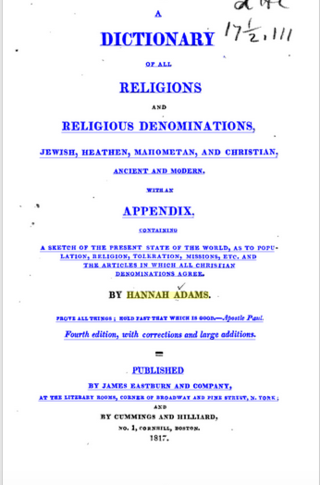
A Dictionary of All Religions and Religious Denominations is a 19th-century comprehensive survey of world religions by the American author, Hannah Adams. It was first published in Boston, Massachusetts in 1817.
Martha A. Boughton was an American educator, author, poet, and clubwoman. She wrote biographies as well as religious music and lyrics. Among her publications can be counted Memoir of Rev. John Motte Arnold, D.D. (1885), The Quest of a Soul, and Other Verse (1911), Onward (1918), and Mystery and Other Poems (1926).

Florence E. Kollock was an American Universalist minister and lecturer. She organized and served as pastor of the Stewart Avenue Universalist Church, Chicago, 1878–92. She subsequently served as pastor of the Universalist Church, Pasadena, California, 1892–95, where, with a membership of nearly 500, it was the largest congregation in the world under the charge of a woman. From 1904 till September 1910, she was the pastor of St. Paul's Universalist Church, Jamaica Plain (Boston), Massachusetts. Kollock served as President of the Woman's Centenary Association,, 1902–3. She lectured extensively in the U.S. and abroad on sociological and philanthropic problems. She was prominent in all reformatory and educational work, including the temperance movement and women's suffrage.

Sarah Katherine Taylor was an American evangelist and temperance activist. She was the editor of, The Little Christian, All Nations Monthly, and Bible Faith Mission Standard.
















